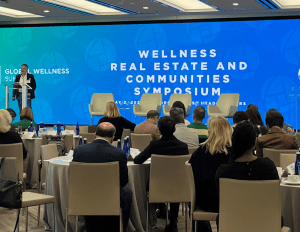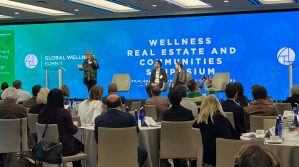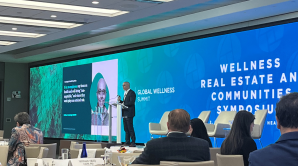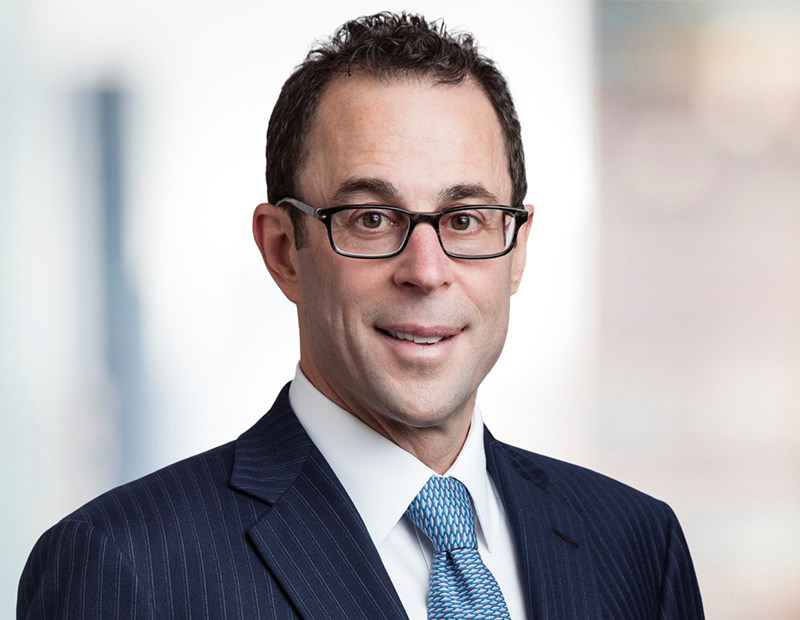Why Well-Being in CRE Projects Is a Must
Experts at the Wellness Real Estate and Communities Symposium shared strategies for incorporating this vital element in development.

Center stage at the The Global Wellness Institute’s second annual Wellness Real Estate and Communities Symposium. Image by Gabriel Frank
Physical, emotional and even spiritual well-being must play a vital role in the development and uses of commercial properties of all sectors and asset classes, according to panelists at the Global Wellness Institute’s second annual Wellness Real Estate and Communities Symposium.
From air filtration, light exposure and sound quality to sustainable development and employee wellness policy toolkits, the conference showcased the evolution of wellness in the built environment from an amenity to an absolute requirement. The biggest takeaway was seeing to a building’s physical appeal and specifications as having deep impacts on individual physical and mental health.
An evolved industry
A panel discussion between the co-chairs of the GWI’s Wellness Communities & Real Estate Initiative—Jean-Francois Garneau, chief development officer of INITIAL Real Estate and Teri Slavik-Tsuyuki, principal & storyteller of tst ink—showcased the market’s rapid growth. Of note was the resounding acknowledgement of physical health being taken into account in new commercial developments and wellness initiatives.
The panelists highlighted the wellness industry’s growth to $275 billion, and its existence as a prime target for rents, lease terms, tenant satisfaction and well-being, particularly for the ailing office sector. The panelists identified six “channels” for wellness, each being what Garneau described as a “purchase motivator,” for investors and operators trying to create the most healthy environment for their occupants’ well-being.
READ ALSO: Walkability’s Continued Impact on CBDs
The channels were social, physical, mental, environmental, economic and civic, with each metric being entirely based on a property’s location, sector and asset class. “Well-being is uniquely contextual, but getting to the heart of it is critical. “As an industry, we need to recognize that the built environment has a huge role to play in human health. (There is) no point in relying on bricks and mortar,” Teri Slavik-Tsuyuki said.
Human-centric developments

A discussion between Kathryn Scheckel, Peter Epping of Hines and Teri Slavik-Tsuyuki. Image by Gabriel Frank
Bricks and mortar still play a role, however. As a case study in development that integrates the above into ESG initiatives, Slavik-Tsuyuki moderated a discussion between Kathryn Scheckel, head of Hines’ Global Venture Lab, and Peter Epping, the firm’s senior managing director & global head of ESG. Describing both health and humanity as the “H” in ESG, the panelists detailed their development goals directed toward the impacts that their properties have on both the individuals that live and work within them, and the communities they are built in.
On the macro scale, Scheckel spoke of bringing all of their development practices to net zero carbon emissions by 2040, a task that goes hand in hand with broad surveys of customers and the distribution of newsletters asking how their spaces have impacted their livelihoods. On the micro scale, with occupant wellness in mind, Scheckel referred to new developments as “labs,” where the firm invites entrepreneurs to test their ideas and innovations, prioritizing the creation of the best possible experience for employees.
“Employers and clients have woken up to the fact of how much space affects productivity,” Scheckel added. To Hines, office work means more than working out of a cubicle; it is a matter of experience. “How you dress your space, what you communicate (through its design) and the aesthetics inform the experience working there,” Scheckel concluded.
Such a theme carried over to another panel discussion that covered the role of culture and the arts as a mainstay in more public commercial properties. Using the High Line, Lincoln Center and One Vanderbilt as examples, John Alschuler, executive chairman of wellness and amenity curation firm Therme Group, spoke of aesthetic choices that have transformed the traditional visions of spaces from “hermetic boxes” of work and living to “experiences” based on “connective, communitarian events.”
While the first may be a park, the second a concert hall and the third an office building, what they all have in common is their ability to provide immaterial benefit to the consumer through their aesthetic appeal and experiential focuses over material consumer goods. To some at the conference, this seemed like a value that has been lost, as developers seek profits over personality. “(They are) restoring their own connection that was lost with the commoditization of commercial real estate,” Alschuler added.
Measuring what matters
In discussing the importance of the experiences that commercial spaces provide, as opposed to their value, many speakers emphasized the importance of physical well-being and the impacts that light exposure, air quality, sound and temperature have on commercial spaces.
Matthew Trowbridge, MD, chief medical officer of the International WELL Building Institute and an Associate Professor at the University of Virginia School of Medicine cited a new poll from the institute that showed 8 in 10 employees saying that a focus on wellness in their spaces is a non-negotiable component of in-person office work. This goes beyond physical health to more specific issues such as welcoming employees with disabilities. “It shows strategic investments in health and well-being have an impact on people and profit,” Trowbrige said, acknowledging the direct correlation.
In practice, this can translate into how the buildings are physically perceived. Joseph Allen, an Associate Professor of Exposure Assessment Science and Director of the Healthy Buildings Program at the Harvard University Center for the Environment cited the newfound pattern that tenants and employees have in influencing these elements, one being air quality, in part due to their ability to measure them. “Portable sensors are changing the market, (they) can track the real time air quality performance of a space,” Allen explained. “Up until now, you could have gotten away with (only) air filters; but you can have employees and staff asking if you can have five air changes per hour.”








You must be logged in to post a comment.